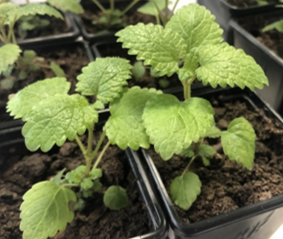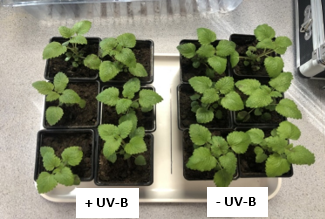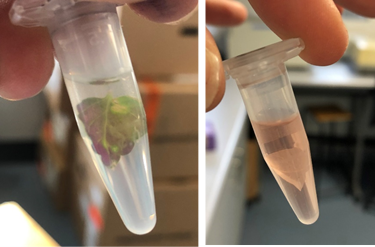UV effects on Melissa officinalis (lemon balm)
by Gaia Crestani, School of BEES, University College Cork
Introduction
Melissa officinalis L., commonly known as lemon balm (Figure 1), belongs to the family of Lamiaceae, like many aromatic plants such as mint, sage, rosemary, thyme and basil. It is a herbaceous perennial, native to southern Europe and the Mediterranean where it grows freely. The name Melissa is derived from the Greek word for honeybee, and officinalis is Latin, referring to its use as a medicinal plant. Indeed, the flowers of lemon balm are very attractive to bees and the aromatic leaves of lemon balm are commonly used in desserts and herbal teas.

This fragrant plant is rich in essential oils, monoterpenes, triterpenes, phenolic acids and flavonoids, which are bioactive compounds. This explains why a great number of pharmacological uses for the plant are reported such as an antioxidant, antimicrobial, or antispasmodic agent, or as a treatment against insomnia (1).
Environmental stress
In the natural environment, plants are continuously exposed to a variety of stressors such as drought, salinity, low/high temperatures, ultraviolet radiation (UV-A and UV-B) and pathogens. The response to these factors depends on the plant species and on the type of stressor. Commonly, plants avoid or tolerate stresses by inducing stomatal closure, reducing photosynthesis, increasing production of reactive oxygen species (ROS) and/or antioxidant activity. Another defence response is the modification of the plant’s secondary metabolite composition and consequently the nutritional and/or pharmaceutical value of crops (2).
One of the environmental factors that can have a major effect on plant growth and morphology, even after a short exposure time, is UV-B radiation.
UV-B radiation
The light emitted by the sun has an “invisible” component: ultraviolet radiation (UV). UV comprises short wavelength radiation, and can be divided in UV-C (200–280 nm), UV-B (280–315 nm) and UV-A (315–400 nm). Historically, the interest in UV radiation derived from the depletion of the stratospheric ozone layer due to emission of chlorofluorocarbons, and related compounds. This depletion led to an increase in UV-B in the biosphere. Currently, the ozone layer is recovering and UV levels are expected to decrease. UV-B effects on plants depend on multiple factors such as intensity, wavelength, exposure time and previous acclimation of the plant. Generally, the regulatory effects of UV-B can be classified in two different groups: morphological or biochemical.
UV-B effects on plants
Morphological effects of UV-B include the reduction of plant height and leaf length/leaf area, and increased axillary branching. In general, UV-B radiation reduces the dimensions of different plant organs (3). These effects are clearly visible in Melissa officinalis plants exposed to UV-B (Figure 2). In the experiment shown,plants were grown for one week under visible light with or without supplemental UV-B, showing smaller plants with fewer leaves in plants exposed to UV-B.

Bioactive compounds
One of the main strategies that plants have adopted as a physiological defence mechanism is the increased production of UV-absorbing pigments such as phenols, flavonoids and anthocyanins. Increased levels of these compounds, especially in leaves, reduce penetration of UV radiation into the lower layers of the leaves, thereby limiting UV damage.
The presence of these pigments in lemon balm leaves is shown in Figure 3. On the left is a leaf directly after UV treatment, on the right anthocyanins were extracted using acidified methanol.

Importantly, these same pigments are also recognised as bioactive compounds, promoting aspects of good health. Bioactive compounds may help prevent oxidative stress related disorders such as cardiovascular diseases, cancer and age-related pathologies (4).
These compounds, especially phenols and flavonoids, are naturally found in many fruits and vegetables. If UV-B could be used to increase the concentration of these substances in our food, the health benefits of fruit and vegetables could be increased. Similarly, these stimulatory effects of UV-B on plants can be important for plants grown for their pharmaceutical components, where the quantity of bioactives that can be extracted is crucial in the preparation of supplements, medicines or cosmetics product.
Bibliography
1. Miraj S, Rafieian-Kopaei, Kiani S (2017) Melissa officinalis L: A Review Study With an Antioxidant Prospective. J Evid Based Complementary Altern Med. 2017 Jul;22(3):385–94.
2. Mewis I, Schreiner M, Nguyen CN, Krumbein A, Ulrichs C, Lohse M, et al. (2012) UV-B Irradiation Changes Specifically the Secondary Metabolite Profile in Broccoli Sprouts: Induced Signaling Overlaps with Defense Response to Biotic Stressors. Plant Cell Physiol. 2012 Sep;53(9):1546–60.
3. Kataria S, Jajoo A, Guruprasad KN (2014) Impact of increasing Ultraviolet-B (UV-B) radiation on photosynthetic processes. Journal of Photochemistry and Photobiology B: Biology. 2014 Aug;137:55–66.
4. Leicach SR, Chludil HD (2014) Plant Secondary Metabolites. In: Studies in Natural Products Chemistry [Internet]. Elsevier; 2014 [cited 2020 Feb 11]. p. 267–304. Available from: https://linkinghub.elsevier.com/retrieve/pii/B9780444632814000094
